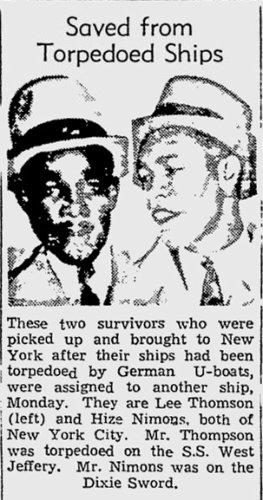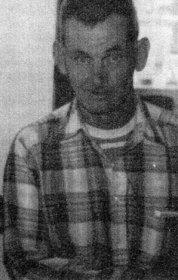Wartime Heritage
ASSOCIATION

The Wreck of the SS West Jaffrey
On the cold winter night February 8, 1942 the freighter, SS West Jaffrey, moved along the coast of Nova Scotia. It travelled
at eight or nine knots toward the port of Halifax, en route from New York, to join an Atlantic convoy going overseas. The ship’s
captain stayed close to land in an attempt to evade German subs.
Frank Nickerson told the story of the wreck of the West Jaffrey to Samantha Haley, a history
student at Yarmouth Consolidated Memorial High School in April, 2005.
The West Jaffrey hit something, Frank Nickerson thought it may have been the ‘Peter Stuart’, a
rock named after the ship that hit the rock in 1892. The West Jaffrey, a 10,000 ton freighter, hit the
ledge and started going down right off of Outer Bald Island. Knowing the freighter was sinking the crew
of about thirty men scrambled the decks and cargo areas to get rid of the TNT. They started opening all
the crates marked “explosive” and throwing them overboard. Once the explosives got wet they were
no longer a threat.
The crew managed to escape the ship before it went down with all the cargo. Fighter planes,
tanks, trucks, food made up the cargo. Within a day or two a tow ship from Halifax arrived and tried to
move the West Jaffrey, but was unsuccessful. It was not possible to budge the ship. In the following
day, for a period of several weeks, ‘lighters’, barge like crafts, began to salvage some of the heavy
equipment on board.
“Living on the Tusket Islands, there was always a lot of salt herring
and salt pollock. Butter and sugar were harder to get your hands on, and
how much depended on the size of the family.” Frank was about ten or
eleven at the time and recalls his father, Gordon Nickerson, rowing out in his
dory to Outer Bald Island from their home on Deep Cove Island. “Gas engines
were quite uncommon then”. Frank and his father went out to the wreck and
got two or three dory loads of food. “The food was in gallon-sized cans, the
labels had washed off in the wreck, but it was food you couldn’t ask for
anything more. It was free food in wartime.”
The West Jaffrey has a lot of canned good aboard and a freezer full of
beef. Frank, thinking back to a few times when opening the cans, recalled:
“One never knew what they were opening. You had to shake the can around
and take a guess as to it s contents. You would open a can that sounded like
potatoes for supper and be stuck eating a gallon sized can of peaches that
night. Once we opened what we thought was maybe tomato soup or
something of similar texture and it turned out to be a gallon of fingernail
polish. With not many girls on the island, especially none that painted their
nails, we sent it to Candlebox Island the following week for the lighthouse
keeper to give to his daughters”.
The polish would have been used to paint on the equipment as it would
keep machinery protected, shedding the water off of it.
Going to the wreck, Frank recalls that all along the shore near the giant, grey, steel freighter were the crates that were
thrown overboard. “Explosives were not something a lot of people knew about at the time. All that was left in the crates were
little shavings of what appeared to be heavy sawdust but smelled sour. It was the remainder of the wet TNT. The children were
picking up artillery shells on the shore and making bonfires and throwing the shells in and running. It took about five minutes
for them to heat up enough to go off. They would climb up the ladder on the side of the ship and slid across the steel decks that
were dripping of oil. The wheelhouse was quite big and had a lot of brass”. There were not a lot of things like compasses by the
time Frank got around to the wreck as a lot of people had gone to the ship to get what they could.
“The West Jaffrey was there for a couple of years before it broke up. The ship
was full of oil for the longest time, like an intravenous line dripping oil into the ocean.
Birds were getting full of that bunker sea and the authorities came and lit her up to
burn off the oil. It was nothing but a ball of flame and black smoke for at least a
week”.
At the time of the wreck, there was much speculation locally as to how and why
the ship hit the ledge off the Tusket Islands. Some believed that the Captain
deliberately ran aground.
A New York newspaper, shortly following the wreck, reported that Lee Thomson, a
survivor of the torpedoed ship SS West Jaffrey had been picked up and brought to New
York.
On September 14, 1954 during Hurricane Edna with winds up to 160 Km/h
reported in Yarmouth, the wreck of the United States freighter West Jaffrey was
washed into the sea from its landmark position off Wedgeport.

copyright © Wartime Heritage Association
Website hosting courtesy of Register.com - a web.com company
Additional sources:
http://www.ec.gc.ca/hurricane/default.asp?lang=En&n=1E1CCBFE-1
http://news.google.com/newspapers?nid=2211&dat=19420418&id=Bx0mAAAAIBAJ&sjid=sv0FAAAAIBAJ&pg=2738,1402731
Wreck of the West Jaffrey
February 8, 1942



Frank Nickerson


- World War I - Menu
- WWI Stories and Articles
- Photos - Yarmouth Soldiers
- Selection of World War I Songs
- WWI Casualties of Yarmouth, NS
- Those Who Served - Yarmouth, NS
- WWI Casualties Digby Co. NS
- WWI Casualties Shelburne Co. NS
- Merchant Mariners (1915) Yarmouth, NS
- Canadian Forestry Corps - Non Yarmouth Birth/Residence Enlistments
- US Draft Registry - Yarmouth NS Born


- World War II - Menu
- WWII Stories and Articles
- Telegraphist Air Gunners
- WWII Casualties of Nova Scotia
- US Casualties with NS Connection
- Far East/Pacific Casualties with NS Connection
- Merchant Navy Casualties Nova Scotia
- Nova Scotia WWII Casualties Holten Canadian War Cemetery
- D-Day Casualties - Nova Scotia
- CANLOAN Program Casualties - Nova Scotia
- Battle of the Bulge Casualties - Nova Scotia
- WWII Casualties Yarmouth NS
- Yarmouth Casualties - RCAF RAF Canadian Army WWII
- Yarmouth Co., Marrages WWII
- Casualties Non-Born/Residents with Connection to Yarmouth Co., Nova Scotia.
- WWII Casualties Digby Co., NS
- Non-Nova Scotian WWII Casualties Buried in Nova Scotia
- WWII RCAF Casualties Aged 16-18
- Brothers/Sisters Who Served - World War II













